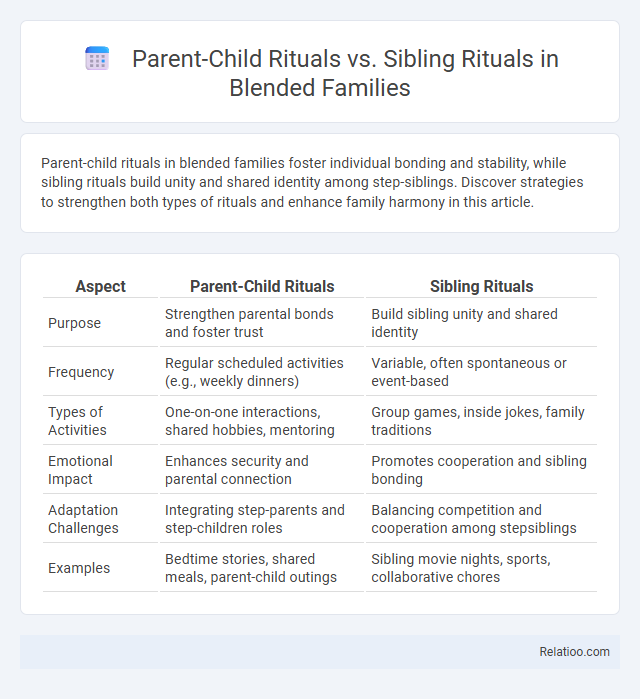Parent-child rituals in blended families foster individual bonding and stability, while sibling rituals build unity and shared identity among step-siblings. Discover strategies to strengthen both types of rituals and enhance family harmony in this article.
Table of Comparison
| Aspect | Parent-Child Rituals | Sibling Rituals |
|---|---|---|
| Purpose | Strengthen parental bonds and foster trust | Build sibling unity and shared identity |
| Frequency | Regular scheduled activities (e.g., weekly dinners) | Variable, often spontaneous or event-based |
| Types of Activities | One-on-one interactions, shared hobbies, mentoring | Group games, inside jokes, family traditions |
| Emotional Impact | Enhances security and parental connection | Promotes cooperation and sibling bonding |
| Adaptation Challenges | Integrating step-parents and step-children roles | Balancing competition and cooperation among stepsiblings |
| Examples | Bedtime stories, shared meals, parent-child outings | Sibling movie nights, sports, collaborative chores |
Understanding Rituals in Blended Families
Parent-child rituals in blended families establish unique bonding traditions that foster trust and stability despite diverse family dynamics. Sibling rituals create a sense of belonging and shared identity, helping siblings navigate changes and build strong connections. Your awareness of these distinct rituals enhances family cohesion and supports emotional adjustment in blended family settings.
The Role of Parent-Child Rituals
Parent-child rituals in blended families serve as crucial anchors for emotional security and relationship building, fostering trust and consistency amidst family restructuring. These rituals promote individual bonding and identity affirmation, which are essential for children's adjustment and well-being in blended family dynamics. Unlike sibling rituals that emphasize peer-like interactions, parent-child rituals provide unique opportunities for guidance, emotional expression, and stabilizing family cohesion.
Importance of Sibling Rituals
Sibling rituals in blended families play a crucial role in fostering strong bonds and emotional security among step-siblings, often compensating for the complex dynamics that parent-child rituals may not fully address. These shared traditions create a sense of belonging and continuity, helping siblings navigate changes and build mutual support systems. Prioritizing sibling rituals enhances family cohesion by promoting empathy, collaboration, and positive interactions that contribute to overall family well-being.
Key Differences Between Parent-Child and Sibling Rituals
Parent-child rituals in blended families often center on establishing authority, nurturing bonds, and creating new traditions to foster a sense of security and belonging, whereas sibling rituals emphasize camaraderie, shared experiences, and conflict resolution among step-siblings. Parent-child rituals usually involve caregiving activities, one-on-one communication, and disciplinary routines, while sibling rituals manifest through collaborative play, inside jokes, and joint problem-solving. These distinctions in ritual functions highlight how family roles and relational dynamics shape the development of meaningful family interactions within blended households.
Benefits of Parent-Child Rituals in Blended Homes
Parent-child rituals in blended families foster secure attachment and emotional stability, helping children navigate complex family dynamics with greater resilience. These rituals, such as shared meals or bedtime routines, enhance communication and trust, which are crucial for integrating stepparents and stepsiblings effectively. Your commitment to consistent parent-child rituals promotes a sense of belonging and identity within the blended family structure, supporting long-term psychological well-being.
Strengthening Sibling Bonds Through Rituals
Strengthening sibling bonds in blended families involves creating unique sibling rituals that acknowledge both shared and individual experiences within the new family structure. Unlike parent-child rituals, which focus on direct emotional support, sibling rituals foster cooperation, trust, and identity among siblings, helping to ease transitions and build lasting connections. Your investment in consistent, meaningful sibling rituals can transform blended family dynamics and promote harmony.
Challenges in Creating Family Rituals After Blending
Blended families face unique challenges in creating family rituals as they must navigate differing traditions and loyalties between parent-child and sibling relationships. Establishing shared rituals that honor individual backgrounds while fostering unity requires sensitivity to each member's history and emotional needs. Your ability to balance these dynamics is crucial for building cohesive family celebrations that strengthen bonds across all relationships.
Tips for Balancing Individual and Group Rituals
Balancing individual and group rituals in blended families requires intentional planning to honor the unique bonds of parent-child and sibling relationships while fostering family unity. You can create personalized rituals that celebrate each child's individuality alongside inclusive family traditions that promote cohesion and shared memories. Prioritize open communication and flexibility to adapt rituals that respect each member's needs and cultural backgrounds, ensuring everyone feels valued within the blended family dynamic.
Examples of Meaningful Rituals for Blended Families
Blended families create unique opportunities for meaningful rituals, such as "family movie nights" integrating both step-parents and step-siblings, fostering bonding and shared experiences. Parent-child rituals like weekly one-on-one dinners help strengthen individual relationships within the new family dynamic. Sibling rituals including game nights or collaborative chore routines encourage teamwork and connection among biological and step-siblings, supporting family cohesion in blended households.
Fostering Lasting Connections Through Family Rituals
Parent-child rituals provide structured opportunities for nurturing individual bonds, while sibling rituals emphasize shared experiences that strengthen peer-like connections within blended families. Family rituals create a cohesive environment by uniting all members in traditions that reinforce belonging and identity. You can foster lasting connections by intentionally blending these rituals to address the unique dynamics of blended family structures.

Infographic: Parent-Child Rituals vs Sibling Rituals in Blended Families
 relatioo.com
relatioo.com